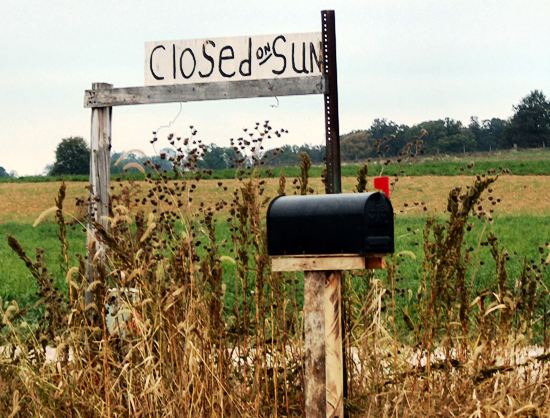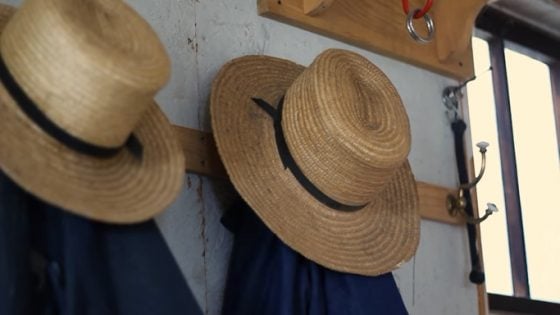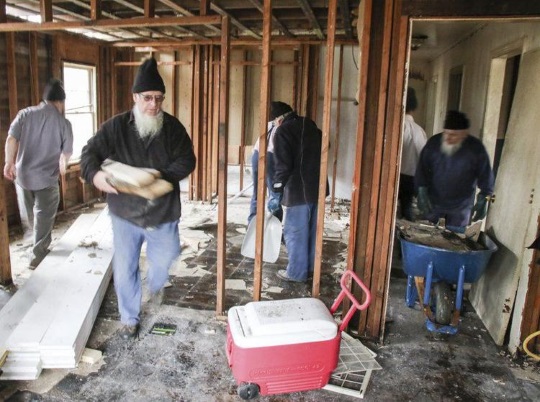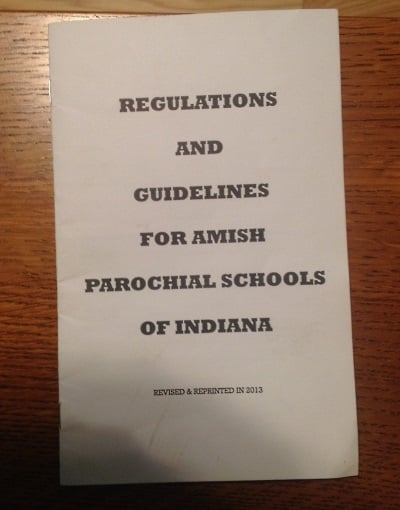Lancaster County Amish Realtor: “We have to move”
On its own, that’s a dramatic statement. There is some context, of course.
First of all, who said it? This was Chet Lapp, a 37-year-old Amishman from Lancaster County. Lapp also happens to be a real estate agent in the community.
From the WITF story by Rachel McDevitt:
Chet Lapp, an Amish realtor, argues more of his fellow Amish should leave Lancaster County for the purpose of preserving their faith.
The vision
Lapp describes himself as a “mad visionary.”
The 37-year-old is responsible for the creation of one of Pennsylvania’s newest Amish settlements, in Glen Rock, York County.
Lapp had been helping Amish families move out of Lancaster County to join other settlements since he got his real estate agent’s license in 2012, but the Glen Rock community is different. Lapp scouted the area with his broker ahead of time, then found people interested in moving.
I’m always curious to learn more about Amishmen in the realty trade. You find a handful who do this business particularly in the larger settlements (Amish realtors exist in Lancaster County, Holmes County, and northern Indiana, to name three places I’m aware of).
I’ve never heard of one describing himself as a “mad visionary”, but it’s a nice touch.
As noted, Lapp was the one behind the Glen Rock Amish community which was started in York County in 2017. He’d like this community to be a “blueprint for the future“.
What makes it a blueprint? It’s far enough away that land is more affordable – yet not too far that regular visits to family in Lancaster County aren’t possible.
Simply put, this model has structure and close-enough proximity to familiar Lancaster County to make a move emotionally easier to stomach.
And why should Amish move? Lapp gives a couple reasons:
- Young people can’t farm anymore: It’s nigh impossible for the average Amish person to break into traditional dairy farming: “For young John Stoltzfus, if you will, to maybe be starting at zero at 21. He’s not going to make — he’s not going to carry a lunch bucket then turn around and pay a million bucks. Ain’t gonna happen.”
- “Stealth” threats to Amish families & culture: For those who go into alternatives like small businesses and construction crews, it means families spend less time together. Influences from spending time with non-Amish outsiders enter the home and threaten Amish culture and traditions.
Bill O’Brien of the Bank of Bird-in-Hand notes that farmland has increased from $8,000/acre to $20,000 in the three decades-plus that he has been giving agricultural loans.
This makes farming extremely difficult or out of reach of the average young Amish family, unless they have other means of acquiring a farm (eg, another successful cash-generating business; a wealthy family to help).
I would just note that produce farming and particularly the organic variety has emerged as a quite viable alternative to traditional dairies, which can be done on much smaller acreage.

The article also makes mention of the recent horse stabling issues as an example of population pressure and its effects (worth noting for those following that story, 2 horses per 1/2 acre is in fact the allowance in Strasburg Township, a much more heavily-Amish township than East Hempfield).
The Oregon Village project is also mentioned as an example of development pressure (we could throw into the mix the incoming Morgantown casino as well).
Lapp sounds motivated to help his people move. I’ll also note however, that Amish moving from Lancaster County in largish-groups a la the Glen Rock model, could be a boon to Lapp’s business 😉
I’m not doubting his sincerity here, just noting it.
For the record, I do believe he believes what he says there about the threat to Amish life. “I’m perfectly content to ride this out until people understand that we have to [move],” Lapp says.
Will Amish leave?
So should we expect an Amish exodus around the corner?
I believe there will always be Amish in Lancaster County (interpret “always” as you wish, but let’s just say “for generations to come”).
However there must be some ceiling on growth – and perhaps the community’s size could even decline at some point, as surrounding areas become increasingly urbanized and surburbanized.
What could that ceiling be? Could the Lancaster County area have twice as many Amish residents in two decades, roughly following typical Amish growth rates (going from about 40,000 to 80,000)?

Or is it more likely to be less than that, with growth slowing as Amish begin following Lapp’s “blueprint” and exiting the community?
Or, you could also envision the center of the community “migrating” over time in a south and/or west direction, away from the denser and more population-pressured areas.
In practice, not many are abandoning the oldest Amish community.
Steven Nolt says “the Lancaster settlement has relatively fewer people as a percentage leaving”…“there seems to be just a stronger attraction or pull in the Lancaster settlement of people staying here, of preferring to take on non-farm jobs and remain here.”
Edsel Burdge, also of the Young Center, says that last year, about 20 households left the county (out of 7,000-8,000 total Amish households in the settlement).
I’m not sure if Edsel means 20 strictly from within Lancaster borders, or including neighboring counties, but whichever it is, it’s not many that left.
An older Amishman explains why Amish wish to stay: “Our roots are here,” he said. “Our ancestors are buried here. We feel attached to this. It’s part of our heritage.”
Those can be powerful reasons to figure out a way to make it work in your home.
Chet Lapp sounds like an interesting person. He is thinking about his people, their future, and has a vision for how it might unfold.
As a relatively young man, he may just see his vision become reality, though it’s hard to say when that might be.









Makes sense
As a neighbor to many Amish families down here in Chester County, it’s easy to see how a young family might be priced out of the market for a farm large enough to sustain them financially. I have been hearing the same from Amish friends and acquaintances for years, actually. The rise of the “boutique” farm, specializing in hard-to-find vegetables, flowers, etc., has come as a boon for some of these families, but not everyone really seems to “trust” this as a viable alternative. Once again, it just makes me respect the Amish community more that they value their faith/lifestyle/beliefs/family more than the almighty dollar.
A question that has been on my mind for some time — why do we not see the Amish (at least around here) raising fiber animals like alpacas, sheep, cashmere goats, etc. and processing that fiber for commercial sale? The knitting, crocheting, weaving community is absolutely RAVENOUS for locally sourced, spun, and dyed fibers, and it seems such a great fit for the Amish. Not as much land needed to raise the animals, jobs for the entire family from toddler to Grandparents, a ready and local end consumer.
Just wondering if there’s some reason the Amish have not seemed to tap into this burgeoning field. Thanks for the great article!
Interesting idea, Marilyn. There is an Amish camel farm in Lancaster County, that’s a milk operation. The Amish I’ve encountered with sheep are primarily milking them as well but I imagine they do something with the wool. How economically viable would such an operation be? How many alpacas, cashmere goats, etc would be needed to support a family? How often do they produce a harvest of wool? These are the questions that came to my mind. It seems like it might make an interesting sideline business for someone, at the least.
What ever benefit may come to the community through the realtor’s knowledge, “mad visionary” is a worldly designation, not something akin to Jesus.
It struck me as odd to hear from an Amishman, rather self-promotional. He is a realtor so in a way self-promotion is part of his business. Probably one reason realty is not a typical Amish line of work.
Another Way.....
The Amish community needs to realize that in order to preserve their lifestyle for future generations to come… They need to get elected to the local government county/township/city councils and become advocates for their causes. If not, it won’t be long until the Amish no longer prosper as they have for years.
That is a standard English way to go about it, but Amish don’t get involved with politics for the most part, and never in the way you describe (wielding power as elected representatives). It has to do with their beliefs concerning nonresistance. So, indirect channels are more viable.
https://amishamerica.com/do-amish-vote/
https://amishamerica.com/why-dont-amish-serve-in-the-military/
This surprised me
Never thought of the possibility that an Amishman would be a realtor. And tooting his own horn. LOL Nothing wrong with that. I can see his point. I just finished reading a book, written by an ex-Amishman, who went to college and became a school teacher while he was still Amish. Another lady I knew, 60 years ago, became a registered nurse. She worked in one of the Lancaster hospitals and never left the Amish. That always amazed me. I also believe the Amish need to get more creative, although there sure are a lot of small businesses that seem to do well. How many Amish are on welfare? Have never heard of any. They will figure out what they need to do to survive and remain Amish. I also remember when I was a kid in the 50’s there was an Amishman on the school board. This was before Amish schools. It would be interesting to know what percentage of Amish vote in elections. I know there are some that do vote.
Good read.
It is strange to hear an Amishman promote himself and business in such a way. Then again, necessity is the father of invention. He found a way to pay the bills without farming in an ever-changing Lancaster environment.
Goes to show that some Amish are slowly assimilating to the Englisch. Behavior and technology.
Interesting read. Basically he admits, in the witf article, that as the Amish are forced to find work off the farm and interact with non-amish, their culture and traditions are being threatened. I believe it. Cause I see it. Especially with some of the younger Amish. There is a change going on with some of them.
Makes us think...
There’s certainly plenty to “give us pause” here. I too am curious about an Amish REALTOR, particularly since I teach licensing courses in Maine. (Laws vary widely from state-to-state.) The practice of real estate brokerage is very dependent on technology and very regulated. I do admire his apparent desire to serve the Amish but wonder how he achieves that given some of the practical considerations.
The larger question posed in regards to what happens to the Amish in Lancaster County is one that could stimulate a great deal of discussion and thinking. I’m almost afraid to get started. 🙂 It’s far from a one-dimensional challenge… wouldn’t it be interesting to attempt to create an “Amish Think Tank?”
I will contribute this: we will not satisfactorily address the challenge until we stop thinking “the Amish have a problem.” The reality is that society has a problem. We are not effectively finding ways to live together.
amish realtors
from my experience where I live in Snyder County there are a couple of Amish Realtors. Amish prefer to deal with Amish for listings and purchasing – they, realtors, have drivers and DO NOT DRIVE. They will show to English. Yes, they are educated to take and get a license, local brokers will sponsor them. To understand Amish ways it is best to live near settlement/ read books by Amish authors and attend a local horse auction (LOL)> yep… . Like my friend tells, “There are many Different sects of Amish, like ice cream, we are many flavors.”
Thanks for sharing that Richard. I found it interesting that there are a couple of Amish realtors there, since Snyder County does not have that many Amish (I am aware of 2 communities at least partially in Snyder County, of 3 and 2 church districts each). I could see how it might be an occupation that “runs in the family” for instance.
So I would guess they are doing a good bit of business in the non-Amish market if that’s the case, or perhaps they work in that capacity on more of a part-time basis?
snyder county, pa. good alternative.
Snyder & Mifflin County Pa. remains strong with Amish farms and alternative businesses. Amish grocery stores are growing with local produce and good prices in general being more convenient to get to. Amish home remodels (for hire) are popular here..plus there’s a presence in local flee markets selling goods. Port Trevorton, Mount Pleasant Mills. Beaver Springs and remote areas going North West towards State College; these areas are holding its own with Amish groups.
One local opened a bicycle shop 15 years ago in Port Trevorton Pa. (Zimmerman’s) and it is going strong….better selections and service then stores elsewhere. Weavers Bakery, Green House and Gift shop on RT. 15 has gone from a simple shed over the years to a major (big building) stop for local and tourists. Amish and Menonnites have newly been creative and inflatred the community here in a positve way.
I disagree that there are threats to Amish culture or lifestyle even as suburbia lurks into their environment. That is an excuse. Amish will have to adapt. Maybe not use horse as much, and use public transit like a lot of Orthodox Jews in Brooklyn use. It depends on the will to keep your culture and faith. Orthodox Jews have maintained their culture and religious convictions just fine in the heart of congestion, capitalism, and fast paced lifestyles.
The Amish who remain in more urban areas will have to adapt as many already have. Most of Lancaster Amish have already adapted. Less than 20% farm. They are already running their own stores and businesses. Not farming doesn’t have tp mean a break down in traditions, an erosion of faith, family, or community. Just as the Orthodox Jews. They have lived 500-yrs in the most urban cities in Europe and America (London, Paris, Brussels, Amsterdam, Brooklyn, etc). They still have 6-7 kids per family. They still raise their kids in their faith. They still wear the clothing of their parents and they still worship the same way.
Amish culture's
settlments.
Thank you.